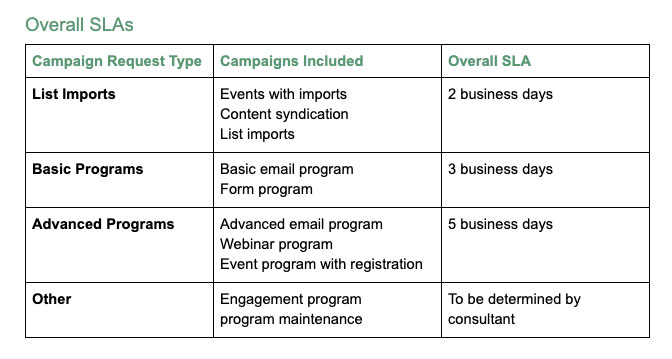Marketing Campaign SLAs
A lot goes into the creation of a marketing campaign, and every campaign build requires collaboration between a company’s stakeholders (typically marketers) and marketing operations team. In order for the campaign build process to run smoothly, companies should establish and implement service level agreements (SLAs).
What are Service Level Agreements (SLAs)?
A Service Level Agreement (SLA) is an agreement between clients/stakeholders requesting a campaign and the MOPs practitioners building the campaign. It defines the campaign production timeline, deliverables for each type of campaign and milestones for when certain work needs to be completed.
Why should a company establish and implement SLAs?
More often than not, the people submitting campaign requests to MOPs practitioners are not familiar with what goes into building campaigns within a marketing automation platform. This tends to lead to misunderstandings by the stakeholder on how quickly their campaign can be completed as well as what is expected from them and the MOPs practitioner in order for it to get done on time. It can also create unnecessary stress and frustration for everyone involved.
Establishing and implementing SLAs, helps manage expectations for each type of campaign build and helps scale campaign operations processes. They also help increase an organization’s campaign efficiency because stakeholders know what information they need to provide at the time of their campaign request, MOPs practitioners will have everything they need to complete their work, and everyone knows what needs to be done in the agreed upon time frame.
When should a company utilize Marketing Operations SLAs?
Whether your company is a startup or a well-established business or your marketing and MOPs teams are small or large, the sooner you can get SLAs put into place, the more smoothly your campaign management processes will be.
How should a company define SLAs?
First, it’s important to note that each campaign type has a different SLA based on the complexity of the campaign, including but not limited to the number of emails, integrations required, and audience factors. For example, a simple email send campaign will require significantly less time to complete than a webinar program with multiple invites, follow up emails, list imports, etc.

If your company doesn’t already use a project management tool, this is a good time to consider it since PM tools can be used to list each step of the campaign build process and indicate who is responsible for completing each step, assign due dates for each step to keep the project on track, share necessary documents, lists, and other assets needed for the campaign build, and allow stakeholders and MOPs practitioners to communicate with each other when questions arise.
With a PM tool in place and a list of the standard campaign types that will be built, stakeholders and the MOPs team should work together to define expected deliverables, responsibilities, and approximate turnaround times for each step in the build process. After a few months, the teams should meet to review the SLAs and make adjustments as needed.
Who should follow Marketing Operations SLAs at a company?
SLAs need to be followed by anyone at your company requesting a campaign build from the MOPs team as well as the MOPs team practitioners themselves. If just one step of the SLA is skipped or shortened, it introduces risk in the campaign launch as well as the overall quality of the campaign.
Conclusion
Implementing SLAs at your company will benefit anyone requesting and building a campaign because they define processes, set expectations on deliverables, and determine a realistic timeline for when a campaign will be completed. Establishing SLAs in conjunction with using a project management tool increases efficiency and quality of campaigns, and provides the ability to scale faster to serve a larger audience.







